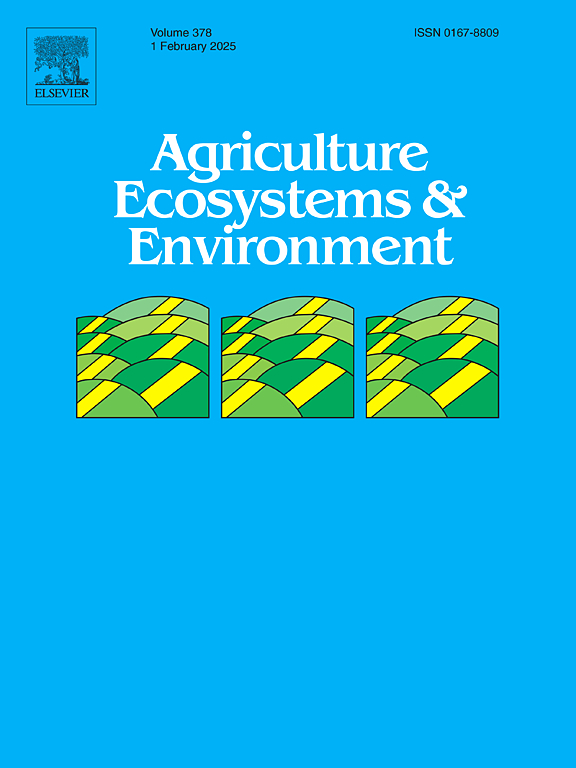在石灰岩丘陵,乔灌木混合植被恢复策略导致植物源碳比微生物源碳增加更多
IF 6.4
1区 农林科学
Q1 AGRICULTURE, MULTIDISCIPLINARY
引用次数: 0
摘要
混合栽培和单一栽培对石灰岩丘陵土壤有机碳的固存均有显著影响,对减缓气候变暖具有重要意义。然而,这些森林中植物和微生物来源的有机碳差异反应的机制仍然知之甚少。在这项研究中,我们测量了木质素酚和氨基糖,以探索2012年在石灰岩山上建立的乔木-灌木混交林和单一栽培林之间植物和微生物来源的碳的差异。结果表明,与单作槭和黄连木混交林(pictum和Pistacia chinensis)相比,pictum × 枇杷和Pistacia × 火棘的植物源碳含量分别提高了73.46 %和40.41 %,碳贡献率分别提高了10.18 %和4.98 %。微生物源碳分别增加了7.65 %和22.22 %,对有机碳的贡献分别减少了9.39 %和1.05 %。值得注意的是,植物源碳的增幅高于微生物源碳,表明其对土壤固碳的影响更为突出。乔灌木混合策略通过影响土壤容积密度、总氮和总磷含量、细根生物量、真菌多样性以及β-葡萄糖苷酶和蔗糖酶活性来提高植物源碳含量和微生物源碳含量,从而提高土壤有机碳水平。鉴于植物和微生物来源的碳对碳固存的深远影响,这些发现强调了石灰岩丘陵优先考虑乔灌混合植被造林策略的重要性。本文章由计算机程序翻译,如有差异,请以英文原文为准。
Arbor-shrub mixed vegetation restoration strategies cause greater increases in plant-derived carbon than microbial-derived carbon in limestone hills
Both mixed and monoculture strategies significantly influence the sequestration of soil organic carbon (SOC) in limestone hills and are crucial for mitigating climate warming. However, the mechanisms underlying the differential responses of plant- and microbial-derived SOC in these forests remain poorly understood. In this study, lignin phenols and amino sugars were measured to explore the differences in plant- and microbial-derived carbon between arbor-shrub mixed forests and monoculture forests established on a limestone hill in 2012. The results indicated that mixed forests of Acer pictum × Ligustrum quihoui and Pistacia chinensis × Pyracantha fortuneana increases plant-derived carbon contents by 73.46 % and 40.41 %, respectively, with corresponding contributions to SOC rising by 10.18 % and 4.98 %, compared to their respective monoculture forests (Acer pictum and Pistacia chinensis). In contrast, microbial-derived carbon increased by 7.65 % and 22.22 %, while their contributions to SOC decreased by 9.39 % and 1.05 %, respectively. Notably, plant-derived carbon exhibited higher increases than microbial-derived carbon, underscoring its more prominent influence on soil carbon sequestration. Arbor-shrub mixed strategies enhanced both plant- and microbial-derived carbon content by affecting the soil bulk density, total nitrogen and phosphorus content, fine root biomass, fungal diversity, and β-glucosidase and sucrase enzyme activities, thereby contributing to an increase in SOC levels. Given the profound influence of plant- and microbial-derived carbon on carbon sequestration, these findings underscore the critical importance of prioritizing arbor-shrub mixed vegetation afforestation strategies for limestone hills.
求助全文
通过发布文献求助,成功后即可免费获取论文全文。
去求助
来源期刊

Agriculture, Ecosystems & Environment
环境科学-环境科学
CiteScore
11.70
自引率
9.10%
发文量
392
审稿时长
26 days
期刊介绍:
Agriculture, Ecosystems and Environment publishes scientific articles dealing with the interface between agroecosystems and the natural environment, specifically how agriculture influences the environment and how changes in that environment impact agroecosystems. Preference is given to papers from experimental and observational research at the field, system or landscape level, from studies that enhance our understanding of processes using data-based biophysical modelling, and papers that bridge scientific disciplines and integrate knowledge. All papers should be placed in an international or wide comparative context.
 求助内容:
求助内容: 应助结果提醒方式:
应助结果提醒方式:


